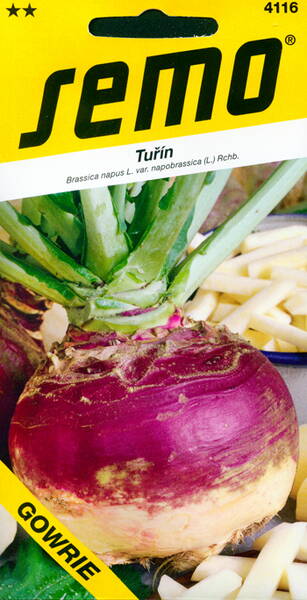Ex Tax: 1.20€
This variety is intended for immediate consumption as well as storage.
It is resistant to Tobacco Mosaic Virus.
The roots are round, red on top and have yellow flesh which has a delicious taste. Sow in April.
The recommended plant spacing is 40 x 30 cm. The growing time from sowing to harvest is 145-160 days.
1,0 g = 300-350 seeds.
* Rutabagas are well adapted to northern conditions. Outwardly, it resembles a turnip, but the taste favorably differs from it - sweet and without bitterness.
And there is more vitamin C in it than in cabbage, beets, carrots. In addition, this vitamin in swede remains until spring.
For therapeutic purposes, juice from root crops is taken. It is effective as an expectorant and diuretic.
Rutabaga is useful for constipation, and gruel from it is used for poorly healing wounds and ulcers.
Rutabaga roots are often oblate-rounded, oval or ellipsoidal, rather large.
The outer color is yellow, greenish, purple or pink, the flesh is yellow or white. The root crop is formed due to the strong thickening of the upper part of the main root.
Rutabaga is a cold-resistant plant. Seeds begin to germinate at +3+5°C, the optimum temperature is +16+18°C.
Leaves and roots form quickly in moderately warm weather.
Rutabaga is demanding on high soil moisture, it does not tolerate both prolonged waterlogging and a strong lack of moisture.
Ridges with any relief are suitable for swede, even with a northern slope, but better with a flat surface.
Carrots, beets, potatoes are considered the best predecessors; plots from under cabbage, turnips, radishes, and radishes are of little use.
Rutabaga is grown by sowing seeds and seedlings, which provides accelerated production for 25-30 days.
For seedlings, seeds are sown sparsely under film shelters from the second half of April. The soil for rutabaga is prepared in the same way as for other vegetable crops.
Organic fertilizers are best applied under the predecessor, mineral fertilizers give an average of 150-180 g per 1 sq. m of potash and 90-120 g of nitrogen and phosphorus.
Seeds are sown or seedlings are planted in rows with a row spacing of 40-45 cm and between plants 18-20 cm.
Plant care consists in regular watering, loosening, especially during the emergence of seedlings, to prevent the formation of a soil crust.
In the phase of 2-3 true leaves, with a seedless method, the plants are thinned out, leaving the best of them at a distance of 7-8 cm at first, and then finally - up to 18-20 cm.
And, of course, weeding, protection from cruciferous fleas and other pests.
For early consumption, swede is harvested 2-3 times selectively after the formation of root crops 8-10 cm in size.
The late harvest is harvested before the onset of cool weather - in September and October, but always before the onset of frost, in dry weather.
After cooling, the root crops are placed in cellars or cellars and stored in the same way as beets. The optimum storage temperature in winter is +1+2°C.












